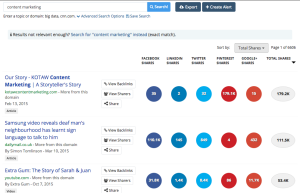— October 26, 2018

Whether we call ourselves a business owner, salesperson, or marketer, there’s a common underlying end-goal to the job we do. Fundamentally, sales and marketing is about using a variety of means and methods to influence an individual to purchase a particular product or service.
And it’s always an individual. Whether you’re selling baby food to a new parent or an enterprise-level solution to a 50-location multinational, it’s a living and breathing human being that decides.
Psychology’s Role In Marketing
It amazes me how little conscious attention most businesses pay to psychology when looking at how to best present their value offering to their audience. I’ve added the word ‘conscious’ to that last sentence for a reason.
Skilled salespeople are sensitive to non-language communication. They can ‘read’ a person’s emotional reaction to something said or written, and use this information to direct the conversation. Perhaps the pitch was planned to focus on how your widget was available on a wider range of sizes compared to the competition. But after hearing a remark from the prospective client about green credentials, you start talking about how your widgets are manufactured using environmentally-sustainable production processes.
Such tactics have their roots in psychology – the understanding human behavior. Since most buying decisions have a strong emotional component, it seems crazy for any business to dismiss the psychological aspect of sales and marketing.
Marketing, in particular, is all about influencing behavior. Whether it’s convincing people to switch brands, pay more, or buy more often, it seems odd that we’re not having more conversations about behavior change and buyer psychology. It seems pretty hard to create any kind of message based on an underlying intention, if we fail to fully grasp how that intention will be harnessed by the people we’re aiming to influence.
The Pratfall Effect: Showing Off Your Imperfections
Imagine you’re in an important meeting, giving a pitch to a big potential client. Near the end of a perfect presentation, you accidentally spill the contents of your coffee mug all over your discussion papers and impeccably-tailored suit. D’oh!
Your pitch was pertinent, insightful, and well-presented…right up until the screw-up at the end that made you want to hide under the desk in embarrassment. If only you hadn’t blown your chances right at the end, right?
Wrong. According to a psychological observation called The Pratfall Effect, your chances of getting the sale just went up, not down.
In 1966, social psychologist Elliot Aronson, together with colleagues Ben Willerman and Joanne Floyd, published The effect of a pratfall on increasing interpersonal attractiveness. What the study found was that people thought to be competent who then make some kind of blunder or mistake – what Aronson describes as a ‘pratfall’ – are considered more likable as a result.
However that doesn’t mean that everyone who makes a blunder becomes more likable. There are other influences such as gender and perceived expertise that contribute to the perception. If someone is considered an expert in a certain area and makes a mistake, they will become more likable. But if an average person makes a similar boo-boo, they will often be viewed in an (even more) negative light. Competency seems to be the core piece of context. If that part is a given, then showing a vulnerability or pratfall increases the desirability. You can read more about The Pratfall Effect here.

Example of Kintsugi
By Haragayato [CC BY-SA 4.0 (https://creativecommons.org/licenses/by-sa/4.0)], from Wikimedia Commons
In Japan, there’s a practice called Kintsugi that uses glue mixed with gold to fix broken items of pottery. Kintsugi thinking is the bowl or cup that’s been repaired is now more ‘valuable’ than before – the gold being used to highlight its imperfection.
Aronson’s research suggests we can view people in a similar way to Kintsugi. Assuming there was an inherent ‘value’ at the start, we find people, products – and even entire businesses – more appealing when they’re seen to exhibit some kind of a flaw, weakness, or idiosyncrasy.
Revealing Flaws Can Increase Appeal
The Pratfall Effect can be seen everywhere – from the famous ads by Avis or VW, to the behavior of so-called reality TV “stars”, even to politicians. It’s a great example of something that goes against what we’d all initially assume: that showing your flaws makes your business more appealing, rather than less.
How come? Perhaps one reason is based upon the growing awareness/intelligence of buyers in relation to brands. All things being equal, as consumers we don’t believe what businesses tell us. If a brand drops the façade and admits a weakness, they’ve put their reputation on the line through the demonstration of their honesty. As a result they become more attractive, and more trusted.
Another potential reason lies in buyer suspicion. I’m sure we’ve all had the experience where a product or service we’ve bought hasn’t lived up to our expectations because something about it was ‘hidden’ from us prior to purchase. This experience has led consumers to conclude that anything they buy has a flaw somewhere. If a brand doesn’t own up and tell them where it is, they may come to their own conclusion – however inaccurate it may be.
Don’t Hide Those Bad Reviews
Showing your business weakness isn’t confined to the product or service itself. It can expand to every part of your customer-facing presentation.
Take online reviews as an example. Spiegel Research Center, part of Northwestern University in Illinois USA, conducted a study on the financial impact to businesses of buyer engagement via online reviews. They looked at data covering 15.5 million page views for 1,800 unique products from 7.8 million visitors, over the course of 12 months.
They came to two main conclusions. Firstly, they found that having reviews for whatever you’re selling was very important. The likelihood that someone would purchase a product that had 5 reviews or more was 270% greater compared with a product without any reviews.
OK, that’s not exactly earth-shattering news – social proof is widely known to influence buying behavior. But their other finding is quite interesting.
They found that when all the visible product reviews had a near perfect rating – 4.9 out 5, or even 5 out of 5 – it corresponded to fewer people going on to buy that product.
There’s a temptation for businesses to hide any of their less-than-stellar reviews. But what the research suggests is that’s exactly the wrong thing to do. We’re on the look-out for the catch – because we’ve learned from experience it’s always there, somewhere. Consumers have learned the hard way that if something looks too good to be true, it usually is.
Warts And All: A Demonstration Of Honesty
So if we can accept the notion that admitting your business, product, or service has flaws and imperfections, then why do so few brands apply such thinking to their marketing?
The same reason why their website says dull, uninteresting things and is designed like 1001 other sites.
Why they continue to sell via reps, distributors, or resellers rather than via channels more aligned with current customer buying expectations.
Why their marketing communication is crammed with outdated clichés and comes from uninspiring and ineffective positioning conceived years ago.
Because they think it’s safe. Oftentimes what’s in the best interests of the brand is not in the best interests of the marketer. If your “warts’n’all” campaign results in poor sales, lost revenue, and reduced market share, waving Elliot Aronson’s research paper at your boss probably isn’t going to save your job. If you’re after security and safety, having the guts to show your failings is probably a step too far.
However if you want the best chance of growing your brand after years of sales complacency and stagnation, pointing out your imperfections (before your competitors do) is sure to get you noticed.
Business & Finance Articles on Business 2 Community
(116)






